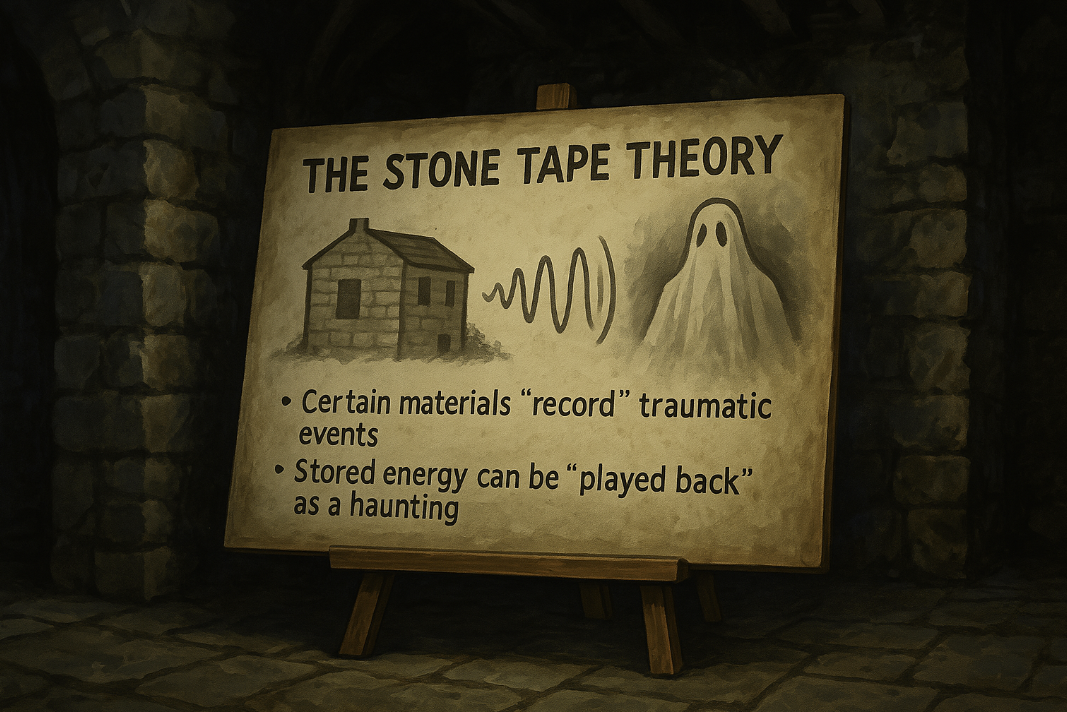
Exploring Stone Tape Theory: A Psychological Perspective on the Paranormal
Share
For centuries, human beings have been fascinated by the idea that buildings, objects, and environments can retain the energy or emotions of past events. This concept, often associated with paranormal phenomena, has gained traction in both popular culture and scientific circles. One intriguing theory that attempts to explain these strange occurrences is the Stone Tape Theory. It is well worth time to conduct an analysis of this theory through a para-psychological lens, exploring its origins, a famous case study, and its implications for our understanding of human experiences with the supernatural.
What is the Stone Tape Theory?
The Stone Tape Theory suggests that certain materials—particularly stone—have the ability to "record" emotional or traumatic events, which can then be re-experienced or "played back" under certain conditions. According to this hypothesis, the stone or building materials themselves act as a kind of tape recorder, preserving the energy from intense emotional or physical experiences. This stored energy, when triggered by environmental factors such as changes in temperature, humidity, or even the presence of particular individuals, can manifest as a haunting or ghostly experience.
The theory was first proposed in the 1970s by British scientists, and the idea is often linked to the phenomenon of residual hauntings. In these hauntings, people report seeing apparitions or hearing sounds associated with a past event, but these occurrences are not tied to the spirits of the deceased. Instead, they are thought to be recordings of past trauma or emotions, replaying in a loop as though the environment is echoing the past.
Famous Case Study: The Enfield Poltergeist
One of the most famous and often cited case studies in connection with the Stone Tape Theory is the Enfield Poltergeist case. Occurring between 1977 and 1979 in a house in Enfield, England, this case involved a series of strange and terrifying paranormal events. The Hodgson family, particularly two sisters, were reportedly subjected to violent poltergeist activity. Furniture would be thrown across the room, unexplained noises would echo through the house, and the girls were even levitated at times.
Though the case has remained controversial—some sceptics argue that the events were hoaxes or caused by natural phenomena—many paranormal researchers continue to speculate that the Enfield haunting could be explained by the Stone Tape Theory. The house where the events took place had a dark history, with reports of past violence and trauma tied to the location. Some suggest that the stone walls of the house might have absorbed the negative energy from these past events, triggering the haunting when environmental conditions aligned.
In particular, one theory posits that the emotional energy of past occupants or victims was "etched" into the very fabric of the house, waiting to be released in a moment of psychic sensitivity. This would explain the repetition of the same phenomena—objects moving, unexplained noises—seemingly independent of human influence.
Psychological Analysis: The Mind and the Environment
From a psychological standpoint, Stone Tape Theory aligns with a fascinating intersection of human perception and environmental influence. It’s crucial to acknowledge that humans are sensitive to their surroundings, and psychological factors such as trauma, suggestion, and expectation can significantly shape the way people interpret sensory information. In the case of the Enfield Poltergeist, for example, the family was already in a heightened state of anxiety, making them more prone to experiencing unusual phenomena. The power of belief can also not be underestimated; once people are convinced they are in a haunted place, their minds may start to perceive normal occurrences—such as creaky floorboards or drafts—as paranormal.
Additionally, the environment itself plays a crucial role. In the case of the Enfield house, there was evidence of dampness, poor ventilation, and creaking floorboards—all factors that could contribute to the perception of paranormal activity. A study published by the British Psychological Society in 2000 suggested that low-frequency sounds, often called infrasound, can induce feelings of unease or even visual hallucinations. In this sense, the environment in a location like Enfield could trigger psychological responses that are mistakenly interpreted as paranormal.
But what about the Stone Tape Theory itself? Psychologically, it could be seen as a metaphor for the way the human mind retains memories of trauma. Just as a person might replay a traumatic experience in their mind, the theory suggests that places or objects might "record" the emotional intensity of such events. While this remains speculative, it raises intriguing questions about the intersection of psychological trauma, memory, and our physical surroundings.
Final Position
The Stone Tape Theory offers a fascinating perspective on how emotional and traumatic events may leave an imprint on the environment, creating the potential for paranormal experiences. The Enfield Poltergeist case stands as a famous example of how this theory might manifest, though its true nature remains a subject of much debate. As a paranormal psychologist, I believe that understanding these phenomena requires a blend of psychological and environmental factors. Whether or not buildings can "record" events, the psychological impact of a place, the power of belief, and the role of suggestion are undeniably crucial in shaping our experience of the paranormal.
In the end, the Stone Tape Theory invites us to reconsider the relationship between the past and present, and how the spaces we inhabit may influence our perception of reality. While it remains an unproven concept, the theory continues to spark the imagination of those fascinated by the mysteries of the supernatural.
